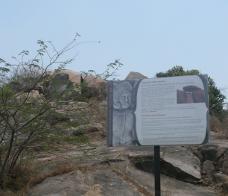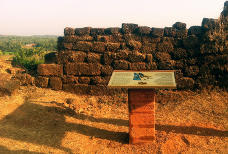Listing of heritage buildings in Bangalore
A first inventory of heritage buildings in Bangalore was done in the 1980s when more than 800 heritage buildings were identified. This listing is in the process of being revised.
The first phase of the revised listing covered the army buildings in Bangalore. Listing work is ongoing at Cubbon Park and covers both built and natural heritage
Our first cut of the heritage inventory of Gavipuram, South Bangalore, handled by Ms Kuili Suganya, conservation architect. The study shows a concentration of more recent temples around the lake; the older temples are at an elevation and all of them are shaded by ancient Peepal (Ficus reliogiosa). The Maratha community settlement and other residential extension are dated to the 1950s and 60s.

Photo: Pramod MR
Signage installed for ASI, Dharwad Circle, Koppal District
Interpretive Signage at Gavimutt, Palkigundu,
Koppal District, for ASI
More than 2200 years ago, the Mauryan emperor Ashoka the Great ruled over much of India. During his reign, Ashoka had edicts installed all over his kingdom, many of them talking about dhamma. Two such rock edicts are found near Koppal in north Karnataka. INTACH Bangalore installed interpretation signs at these important historical sites. Using maps, drawings, photos and bilingual text, the attractively designed signs explain the importance of the two sites to visitors. Both sites are protected by the Archaeological Survey of India (ASI), Dharwad Circle.
Project team: Palikgundu and Gavimatt
Project Coordinator: Pankaj Modi
Concept, research & writing: Meera Iyer
Illustration and design: Nikita Jain
Kannada translation: Derek Anil
Installation: Pramod MR (Ankanaa Associates)

Photo: Pramod MR
Signage installed for ASI, Dharwad Circle, Uttar Kannada District

Photo: Pramod MR
Interpretive Signage at Mirjan Fort and Bhatkal,
Uttara Kannada, for ASI
Did you know that Bhatkal was once the most important port of the mighty Vijayanagar Empire? Or that Mirjan was once ruled by someone with the colourful epithet of the Pepper Queen? These tidbits figure in the interpretive signage that we installed at Mirjan Fort and Bhatkal. As always, the signs live up to INTACH Bangalore's USP with interpretive signage: Well-researched bilingual text written in easy-to-understand language, accompanied by maps, illustrations and photos, to make for visually appealing, accessible signage. The signage was installed at Mirjan Fort and at a number of sites in Bhatkal that are protected by the Archaeological Survey of India (ASI), Dharwad Circle.
Project team: Bhatkal & Mirjan
Project Coordination: Pankaj Modi
Concept, research & writing: Meera Iyer
Illustration and design: Sneha Prasad
Panel mount design: Akhila and Namrata (Pillars and Arches)
Kannada translation: Anil Jagalur
Translation review: Sharmila Aravind
Installation: Pramod MR (Ankanaa Associates)
Onsite co-ordination: Pillars and Arches
Heritage Zones of Bangalore
On World Heritage Day 2010, INTACH Bangalore together with Udayabhanu Kala Sangha initiated a project-based dialogue on Gavipura. Once a pleasant village of gentle hills, water bodies and fertile fields, Gavipura is today one of Bangalore's unique urban centres, an interface between village living and urbanized contexts.
INTACH has proposed declaring Gavipura a heritage zone, with appropriate signage, street furniture and developments at the Gavigangadhareshvara temple, the Kempegowda tower, Kempambudhi kere and the vicinity. Proposals have been submitted to the concerned ministers and corporators


